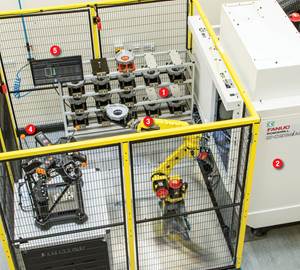Big Data Is A Big Deal
Big Data represents a huge opportunity for metalworking manufacturers.
It’s easy to imagine a cosmetics company wanting to analyze billions of website visits, Twitter feeds, video viewings, image searches and other records of online activity to determine what shade of lip gloss is worn by the most popular celebrity fashion stars and is getting the most attention from teen and tween buyers. The results might show that the next blistering sales trend is likely to be burnt tangerine—and the company still has enough time to launch the sizzling product line that will catch this wave.
This scenario illustrates what Big Data is all about—the ability to find significant trends or emerging patterns detectable only by rapidly scanning many millions of unstructured data items in different formats from a multitude of diverse sources.
So now consider a manufacturing company whose end products consist of components that have crossed numerous CNC machines in its own factories and those of its smaller subcontractors and job shop suppliers. Those same components may have been touched by thousands of cutting tools along the way. Let’s say each of these CNC machines is being monitored to create streams of data about uptime, internal alarms, operational status signals, energy usage and thousands of other performance characteristics and parameters. Likewise, let’s say each of the cutting tools is being monitored for when, where and how it was used, with details about the speeds, feeds, tool paths, coolant conditions and a host of other performance records added to the mix of data, all streaming into massive online databases in the “cloud.” Oh, and by the way, all of this machine and cutting tool data is associated with each and every one of the components that reach the company’s customers in a finished, working assembly.
The ability to gather and access this huge mass of data (and then make sense of it) is what Big Data means to manufacturing. The prospect of finding the equivalent of the cosmetic company’s burnt tangerine bombshell is just as real and compelling, if not as colorful.
What kind of bombshells will manufacturing companies want to look for? Tracing the failure of a critical component to a subtle deviation in the servo response of a certain machine tool spindle (and how to avoid this problem in the future) might be one example. Tracking down all the similar parts that might be subject to the same failure mode is a related example. Finding that a certain CAM programming algorithm helps a particular end mill remove the most material with the least energy might be another example. The possibilities are virtually boundless.
Moreover, these possibilities are on the near horizon. Developments such as MTConnect help open the torrent of observable events and activities from the shop floor. Meanwhile, proponents and developers of MTConnect-related software are aggressively putting together the data storage strategies, analysis engines, computational frameworks, security measures and other tools to pull explosive findings out of the data mass.
Although implementations of Big Data in manufacturing are still in the early stages, the implications are clear. The results will rock our industry to the core.
Related Content
Reinventing a Precision Shop With a Data-Driven Mindset
When this machine shop lost 90% of its business within three months, a reinvention was in order. Here's how it survived after quickly falling on hard times.
Read MoreCan Connecting ERP to Machine Tool Monitoring Address the Workforce Challenge?
It can if RFID tags are added. Here is how this startup sees a local Internet of Things aiding CNC machine shops.
Read MoreSwiss-Type Control Uses CNC Data to Improve Efficiency
Advanced controls for Swiss-type CNC lathes uses machine data to prevent tool collisions, saving setup time and scrap costs.
Read More5 Stages of a Closed-Loop CNC Machining Cell
Controlling variability in a closed-loop manufacturing process requires inspection data collected before, during and immediately after machining — and a means to act on that data in real time. Here’s one system that accomplishes this.
Read MoreRead Next
3 Mistakes That Cause CNC Programs to Fail
Despite enhancements to manufacturing technology, there are still issues today that can cause programs to fail. These failures can cause lost time, scrapped parts, damaged machines and even injured operators.
Read MoreThe Cut Scene: The Finer Details of Large-Format Machining
Small details and features can have an outsized impact on large parts, such as Barbco’s collapsible utility drill head.
Read More






.png;maxWidth=300;quality=90)



.png;maxWidth=300;quality=90)












